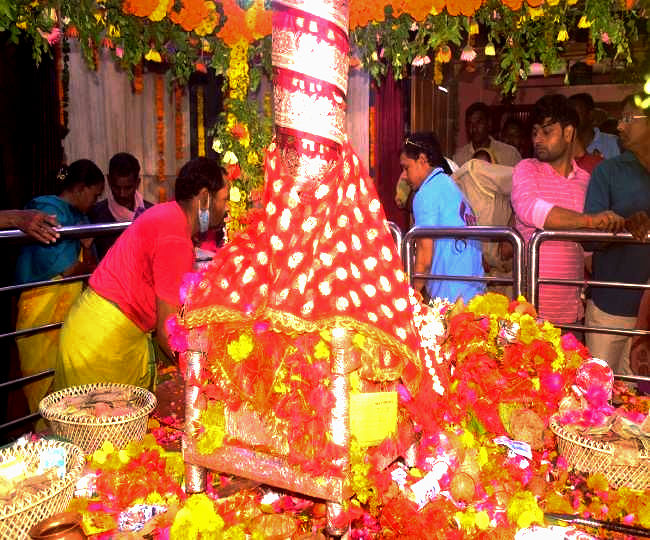Exploring the Shaktipeeths of Prayagraj in Kumbh 2025: Alopin Shankari, Lalita Devi, and Kalyani Devi
- JashnNama
- Jan 5
- 3 min read
Prayagraj, a city steeped in history and spirituality, is not only renowned for the Kumbh Mela and the Triveni Sangam but also for its sacred Shaktipeeths. These revered temples dedicated to the Divine Mother—Alopin Shankari, Lalita Devi, and Kalyani Devi—are vital pilgrimage sites that reflect the city’s deep spiritual significance. Let us journey through the stories, legends, and significance of these Shaktipeeths, where devotion and divinity intertwine.

The Concept of Shaktipeeths
Shaktipeeths are sacred shrines dedicated to Shakti, the divine feminine energy and consort of Lord Shiva. According to Hindu mythology, these sites are where the body parts of Goddess Sati, the first consort of Shiva, fell when her charred remains were carried by the grieving Lord across the cosmos. Each Shaktipeeth is associated with a specific body part or ornament of the Goddess, making it a center of immense spiritual power and devotion.
Prayagraj is blessed with three such revered Shaktipeeths: Alopi Shankari, Lalita Devi, and Kalyani Devi. Each has its own unique history, significance, and spiritual aura.
Alopi Shankari: The Vanishing Goddess
The Alopi Shankari temple is a unique Shaktipeeth located in the Alopibagh area of Prayagraj. The name “Alopi” translates to “disappeared,” and it is believed that the Goddess manifests here in a formless state.
Legend and Significance
According to local lore, during an ancient battle, a chariot carrying the Goddess’s idol disappeared mysteriously at this very spot. Since then, devotees have revered the site as a manifestation of the divine energy that transcends physical form. Unlike traditional idols, the temple’s sanctum houses a wooden platform symbolizing the presence of the Goddess.
Alopi Shankari is particularly popular among newlyweds and couples seeking blessings for marital harmony and prosperity. The temple’s mystical aura and unique history attract devotees year-round.
Festivals and Rituals
The temple comes alive during Navratri, when thousands of devotee flock to offer prayers and partake in elaborate rituals dedicated to the Goddess.
Lalita Devi: The Supreme Shakti of Prayagraj
Lalita Devi is considered the presiding deity of Prayagraj, often referred to as the guardian Goddess of the city. Located in Meerapur, this Shaktipeeth holds immense spiritual and historical importance.
Mythological Significance
It is believed that the fingers of Goddess Sati fell at this site, sanctifying it as a Shaktipeeth. The temple’s name, “Lalita,” signifies the playful and benevolent aspect of Shakti. According to another legend, Lord Rama is said to have worshipped Lalita Devi here during his exile, seeking her blessings before embarking on his journey to Lanka.
Architectural Highlights
The temple boasts intricate carvings and an atmosphere of serene devotion. The idol of Lalita Devi, adorned with elaborate ornaments, radiates divine grace and power.
Festive Celebrations
The temple witnesses grand celebrations during Navratri and Diwali. Devotee light lamps, sing hymns, and offer special prayers, making these occasions a vibrant display of devotion.
Kalyani Devi: The Auspicious One
Located in the Kalyanipur area of Prayagraj, Kalyani Devi is another significant Shaktipeeth, revered as a source of blessings and protection.
Historical and Mythological Roots
The temple’s name, “Kalyani,” translates to “beneficent” or “auspicious.” According to tradition, the earrings (kundal) of Goddess Sati are believed to have fallen here. The temple’s historical roots trace back to ancient times, and its spiritual significance has been upheld by generations of devotees.
Spiritual Significance
Kalyani Devi is worshipped as a benevolent Mother who protects her devotees from misfortunes and grants their wishes. The temple is particularly frequented by those seeking peace, prosperity, and resolution of personal struggles.
Rituals and Offerings
Devotees offer flowers, sweets, and vermillion to the Goddess. Fridays and Navratri days see a significant influx of devotees, creating an atmosphere charged with devotion.
Visiting the Shaktipeeths of Prayagraj
Pilgrims visiting Prayagraj often include these three Shaktipeeths in their itinerary, along with other landmarks such as the Triveni Sangam and Anand Bhavan. These temples not only offer spiritual solace but also provide a glimpse into the city’s cultural and historical richness.
Tips for Pilgrims
1. Timing: Early mornings and evenings are ideal for a serene darshan.
2. Festivals: Plan your visit during Navratri to experience the temples at their festive best.
3. Accessibility: All three temples are well-connected by local transport and are located within a short distance of each other.
4. Etiquette: Dress modestly and follow temple customs to respect the sanctity of the sites.
The Shaktipeeths of Prayagraj—Alopin Shankari, Lalita Devi, and Kalyani Devi—are more than just temples; they are reservoirs of faith, history, and divine energy. Each temple offers a unique spiritual experience, inviting devotees to connect with the divine feminine and seek her blessings. For anyone visiting Prayagraj for kumbh 2025, a journey to these sacred shrines is an enriching experience that nourishes both the soul and the spirit.
.png)

Comments